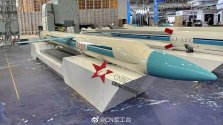@Strangelove bro the width of both theYJ18 and YJ12 seems similar in size from the photo above, if it is then YJ 12 can be modify to launch vertically using the UVLS?
It would require a specific booster for this. It is not just a question of fitting the missile to the VLS, but the question can the missile attain its minimum engine ignition speed. Failure to do so the missile will sputter and fall.
A ramjet needs to attain a certain high airspeed before there is sufficient air compression for the engine to ignite.
A turbofan powered missile, which I think is what powers missiles like the Tomahawk, the Kalibr/Klub and the YJ-18, only needs a low air speed for the engine to ignite. This puts lower requirements for the rocket booster to attain the minimum speed for engine ignition. Rocket powered missiles, of course, don't require air, makes VLS easy.
Turbojet missiles require a higher speed, and so would require a longer and more powerful booster if it is from a VLS position than a slanted position. Its easier to attain the minimum speed from a slanted position than a vertical one. This is why we don't see Harpoons, Exocets and YJ-83s in VLS.
Ramjet missiles require even higher speeds than turbojets. The vast majority of them are fired from a slanted position so they can attain their minimum ignition speed easy. This might have been a factor why countries like the US rejected air breathing supersonics as it would be difficult and incompatible with their must use the VLS policy.
The exception to that is the Oniks, aka Brahmos for its Indian variant. This can also help explain why it can be possible with the YJ-12.
The Oniks uses an integrated booster. This means the ramjet chamber is filled with solid rocket propellant, making it a temporary rocket engine. In addition to this, you put a second booster below. The first booster pushes the missile out of the VLS, then falls away, and the integrated booster ignites. As it gains speed, the rocket fuel in the ramjet chamber burns away until nothing is left of the rocket fuel, clearing the chamber completely. At this point, the missile attain the minimum speed for the ramjet engine to burn, and the missile opens its air inlets and sprays fuel to the empty chamber.
The Moskit missile also uses the same principle, and so does the Kh-31 Krypton. By extension, the Chinese YJ-91, which is a copy of the Kh-31.
The YJ-12 appears to be another missile that uses an integrated rocket booster-ramjet chamber. Missiles like these do not have external side boosters or a large primary booster to reach ramjet ignition speeds.
In theory the YJ-12 could, the question is, given its length, and the maximum length of the U-VLS, how much length would the primary booster be in order to lift the missile and give the missile as much head speed before the missile fires its integrated booster. One thing for sure, it can't use the same booster as it is when launched from the slanted canister. It would require a longer and more powerful booster. The rest is rocket science math to design such a booster. But maybe the institutes didn't want to continue because it would be moot and redundant when you already have the YJ-18. Still, I think there is still export potential to this, especially to Pakistan for a future warship design.
I remember there was an Oniks like missile that was shown in the last Zhuhai.

